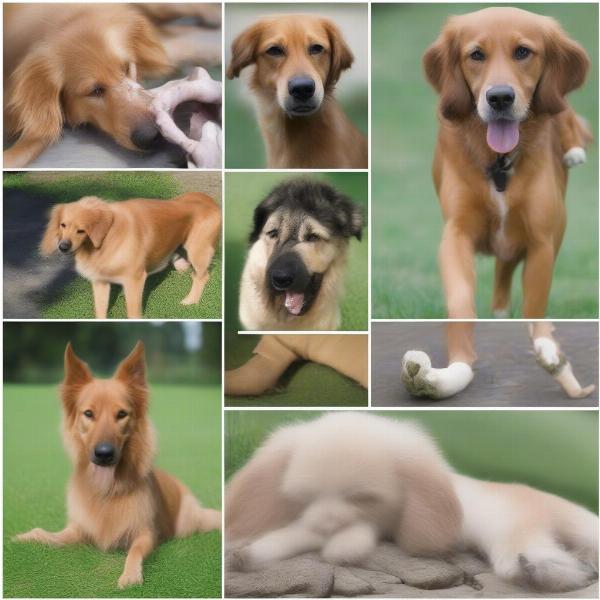Dog paw bones are a crucial part of a dog’s anatomy, providing support, enabling movement, and playing a vital role in their overall well-being. Understanding their structure and function is essential for every dog owner, allowing for better care and the early identification of potential problems. This article delves into the complexities of dog paw bones, covering everything from basic anatomy to common injuries and preventative measures.
The skeletal structure within a dog’s paw is a marvel of biological engineering, comprising numerous small bones working in harmony to facilitate a range of activities, from walking and running to digging and playing. These bones, ligaments, tendons, and muscles are interconnected, enabling complex movements and bearing the weight of the dog. Knowing the basics of this intricate system can help you better understand your furry friend’s needs and potential vulnerabilities.
The Intricate Architecture of Dog Paws
A dog’s paw is not a single, solid structure, but rather a complex arrangement of bones, categorized into three main sections: the phalanges, metacarpals/metatarsals, and carpals/tarsals. The phalanges are similar to the bones in our fingers and toes, forming the individual digits of the paw. The metacarpals in the front paws and metatarsals in the rear paws connect the phalanges to the wrist (carpals) and ankle (tarsals) respectively. These groups of smaller bones provide flexibility and shock absorption.
Phalanges: The Toes of Your Dog
Each toe, except the dewclaw, has three phalanges, similar to our finger bones. These bones give the toes their flexibility and allow the dog to grip surfaces. The dewclaw, often located higher up on the paw, has only two phalanges.
Metacarpals/Metatarsals: Connecting the Paw
These bones connect the phalanges to the carpals (wrist) in the front paws and tarsals (ankle) in the rear paws. They provide structural support and act as levers for movement.
Carpals/Tarsals: Wrist and Ankle
These groups of small bones form the wrist and ankle joints, providing flexibility and range of motion. They also absorb shock, protecting the limbs from impact during activities like running and jumping.
Common Paw Bone Injuries and How to Spot Them
While dog paws are designed for durability, injuries can occur. Common issues include fractures, sprains, dislocations, and infections. Recognizing the signs of a paw injury is vital for prompt treatment. wall art dog might also be affected if your dog is limping or uncomfortable due to paw pain.
- Limping or favoring a paw: This is the most obvious sign of a paw injury.
- Swelling or redness: Inflammation indicates a problem.
- Excessive licking or chewing: Dogs often lick or chew at injured areas.
- Yelping or whining when the paw is touched: Sensitivity to touch suggests pain.
- Visible wounds or broken bones: Severe injuries may be visually apparent.
 Signs of a Dog Paw Injury
Signs of a Dog Paw Injury
What to Do if You Suspect a Paw Injury
If you suspect your dog has a paw injury, seek veterinary attention immediately. Do not attempt to treat the injury yourself, as this could worsen the situation. Your veterinarian can diagnose the problem and recommend appropriate treatment. dog balloons and other celebratory items should be put away until your dog has fully recovered.
Preventing Paw Bone Injuries
Taking preventative measures can significantly reduce the risk of paw bone injuries. Here are some key steps:
- Regular nail trimming: Overgrown nails can alter a dog’s gait and increase the risk of injury.
- Paw checks: Regularly examine your dog’s paws for cuts, thorns, or other foreign objects.
- Provide a safe environment: Remove hazards like sharp objects and broken glass from your dog’s surroundings.
- Appropriate exercise: Avoid overexertion, especially on hard surfaces.
- Maintaining a healthy weight: Excess weight puts extra strain on the paws. how often to get dogs teeth cleaned is another important aspect of maintaining your dog’s overall health, which can indirectly impact their paw health by preventing them from favoring a paw due to dental discomfort.
Conclusion
Understanding the intricate structure and function of dog paw bones is paramount for responsible dog ownership. By being aware of potential injuries and practicing preventative measures, you can help your canine companion enjoy a happy, healthy, and active life. Remember, regular veterinary check-ups and prompt attention to any signs of discomfort are crucial for maintaining your dog’s paw health. christmas dog stockings personalized can be a delightful treat for your dog, especially when they’re recovering from an injury, but always prioritize their health and comfort.
-
What are the main bones in a dog’s paw?
The main bones include the phalanges, metacarpals/metatarsals, and carpals/tarsals. -
How can I tell if my dog has a paw injury?
Look for signs like limping, swelling, redness, excessive licking, and sensitivity to touch. -
What should I do if my dog injures their paw?
Seek immediate veterinary attention. -
How can I prevent paw injuries in my dog?
Trim their nails regularly, check their paws for foreign objects, provide a safe environment, ensure appropriate exercise, and maintain a healthy weight. -
Why is it important to understand dog paw bone anatomy?
It allows for better care, early identification of potential problems, and informed decision-making regarding your dog’s health. -
Are dewclaws part of the paw bone structure?
Yes, dewclaws are located higher up on the paw and have two phalanges. -
Can overgrown nails cause paw problems? Yes, overgrown nails can alter a dog’s gait and increase the risk of injury.
ILM Dog is a leading international dog care website dedicated to providing expert advice and resources for dog owners worldwide. We offer comprehensive information on dog breeds, health, training, nutrition, grooming, and much more. Whether you’re a new dog owner or a seasoned expert, ILM Dog is your trusted source for all things canine. From understanding the intricacies of dog paw bones to selecting the perfect dog themed christmas tree, we’re here to support you every step of the way. Contact us at [email protected] or +44 20-3965-8624 for any inquiries.